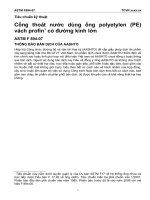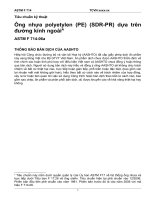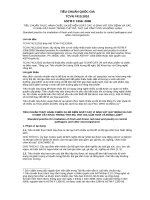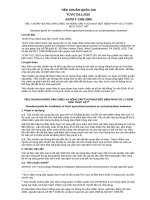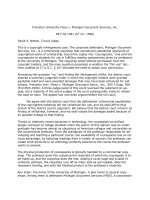Astm f 458 13
Bạn đang xem bản rút gọn của tài liệu. Xem và tải ngay bản đầy đủ của tài liệu tại đây (68.61 KB, 3 trang )
Designation: F458 − 13
Standard Practice for
Nondestructive Pull Testing of Wire Bonds1,2
This standard is issued under the fixed designation F458; the number immediately following the designation indicates the year of original
adoption or, in the case of revision, the year of last revision. A number in parentheses indicates the year of last reapproval. A superscript
epsilon (´) indicates an editorial change since the last revision or reapproval.
This standard has been approved for use by agencies of the U.S. Department of Defense.
bonding and at the same point in processing as the accompanying destructive test. Preferably, this is done immediately
after bonding.
1. Scope
1.1 This practice covers nondestructive testing of individual
wire bonds made by either ultrasonic, thermal compression or
thermosonic techniques. The test is intended to reveal (by
breaking) nonacceptable wire bonds but is designed to avoid
damage to acceptable wire bonds.
1.7 The procedure does not ensure against wire-bond failure
modes induced after the test has been performed.
1.8 The values stated in inch-pound units are to be regarded
as standard. The values given in parentheses are mathematical
conversions to SI units that are provided for information only
and are not considered standard.
1.9 This standard does not purport to address all of the
safety concerns, if any, associated with its use. It is the
responsibility of the user of this standard to establish appropriate safety and health practices and determine the applicability of regulatory limitations prior to use.
NOTE 1—Common usage at the present time considers the term “wire
bond” to include the entire interconnection: both welds and the intervening wire span.
1.2 The practice covers wire bonds made with smalldiameter (from 0.0007 to 0.003-in. (18 to 76-µm)) wire such as
the type used in integrated circuits and hybrid microcircuits,
system in package, and so forth.
1.3 This practice can be used only when the loop height of
the wire bond is large enough to allow a suitable hook for
pulling to be placed under the wire.
2. Referenced Documents
2.1 ASTM Standards:3
F459 Test Methods for Measuring Pull Strength of Microelectronic Wire Bonds
2.2 Military Standard:4
MIL-STD-883 Method 2023
1.4 While the procedure is applicable to wire of any
composition and metallurgical state, criteria are given only for
gold and aluminum wire.
1.5 A destructive pull test is used on wire bonds of the same
type and geometry to provide the basis for the determination of
the nondestructive pulling force to be used in this practice. This
may only be used if the sample standard deviation, s, of the
pulling forces required to destroy at least 25 of the same wire
bonds tested by the destructive pull-test method is less than or
equal to 0.25 of the sample average, x¯. If s > 0.25 x¯, this
practice may not be used.
3. Summary of Practice
3.1 The use of nondestructive wire-bond pull tests is predicated on data obtained from destructive pull tests on typical
samples selected from a lot. The maximum safe nondestructive
pull-force levels are determined as a function of the metallurgical properties of the wire and from the calculated mean (x¯)
and standard deviation (s) of the destructive pull-test data
determined in accordance with Test Methods F459.
NOTE 2—If s > 0.25 x¯, some aspect of the bonding process is out of
control. Following corrective action, the destructive pull-test measurements should be repeated to determine if the s ≤ 0.25 x¯ criterion is met.
3.2 In some cases, rather than use a calculated nondestructive pull force, a fixed pull force may be agreed upon by test
participants. This value may be based upon industry practice,
or some other accepted value, such as that in MIL STD 883,
Method 2023. All other parts of the present ASTM standard
will apply.
1.6 The nondestructive wire-bond pull test is to be performed before any other treatment or screening following
1
This practice is under the jurisdiction of ASTM Committee F01 on Electronics
and is the direct responsibility of Subcommittee F01.03 on Metallic Materials, Wire
Bonding, and Flip Chip.
Current edition approved Jan. 1, 2013. Published January 2013. Originally
approved in 1976 as F458 – 76 T. Last previous edition approved in 2006 as F458 –
06. DOI: 10.1520/F0458-13.
2
This procedure, with current status and limitations, was published in: Harman,
G. G., Wire Bonding in Microelectronics, 3rd Edition, McGraw Hill, 2010,
Appendix 4B.2.
3
For referenced ASTM standards, visit the ASTM website, www.astm.org, or
contact ASTM Customer Service at For Annual Book of ASTM
Standards volume information, refer to the standard’s Document Summary page on
the ASTM website.
4
Available from Standardization Documents Order Desk, Bldg. 4 Section D, 700
Robbins Ave., Philadelphia, PA 19111–5094, Attn: NPODS.
Copyright © ASTM International, 100 Barr Harbor Drive, PO Box C700, West Conshohocken, PA 19428-2959. United States
1
F458 − 13
been turned on, thermally stabilized, and set up by the
manufacturers’ procedure.
8.2.2 For continuous use of a particular bonding machine,
apply either Method A or B (whichever is appropriate) of Test
Methods F459 to a sample of approximately 0.1 % (at least 25
bonds) of the particular wire bond under study after every 2-h
period of bonding.
3.3 The maximum safe nondestructive bond-pull force is
then applied as a screen for individual wire bonds to identify all
bonds with pull strength below the predetermined level of
acceptability.
4. Significance and Use
4.1 The nondestructive wire-bond pull test provides a screen
for evaluating wire-bond quality and is capable of detecting
weak or nonadherent bonds.
8.3 Given a set of n observed values of the destructive
wire-bond pull strength {xi}, i = 1, ..., n, calculate the mean, x¯,
and the standard deviation, s, of the destructive wire-bond pull
test in accordance with the following:
8.3.1 Calculate the average wire-bond pull strength, x¯, as
follows:
4.2 The test is not destructive and does not damage acceptable wire bonds.
4.3 This practice provides a procedure for identifying a
bonding situation that requires corrective action.
4.4 The purpose of this practice is to identify wire bonds
that may fail during subsequent screening procedures or field
operation.
x¯ 5
n
1
n
(x
i51
i
8.3.2 Calculate the standard deviation for the sample, s, by
either of the following:
4.5 The procedure is to be applied after bonding and before
any further treatment.
s5
5. Interferences
H
n
1
n21
( ~ x 2 x¯ !
i51
i
2
J
1/2
,
or (equivalently)
5.1 The same interferences apply as given in Test Methods
F459 (Section 6, Interferences); in addition this test cannot be
used on multi-tiered devices.
s5
H
1
n21
F( ~
n
i51
x i 2 2 n x¯ !
2
GJ
1/ 2
8.4 Using Table 1, select the wire composition and elongation (obtainable from the wire manufacturer), and the relation
between x¯ and s appropriate to the wire bond to be tested and
determine the recommended maximum safe nondestructive
pull (NDP) force from the corresponding entry in the last
column.
6. Apparatus
6.1 The apparatus used for the procedure is identical to that
used in Test Methods F459 except that the lifting mechanism
shall have the capability of stressing the wire bond up to a
predetermined level. As this predetermined level may change
in accordance with the results of a successive series of tests
using Test Methods F459, as well as to accommodate changes
in wire composition and metallurgy, the lifting mechanism
must be capable of applying an adjustable maximum force.
9. Procedure
9.1 Mount the specimen to be tested and set the lifting
(pulling) mechanism to apply the force level determined in 8.4.
9.2 Carefully place the hook under the center of the wirebond loop, as in the previously performed destructive wirebond pull test.
7. Sampling
7.1 As the test is nondestructive. As such it may be used as
a 100 % production line screen so that sampling is not required.
9.3 Set the rate of force application at the same as that used
in the destructive test.
7.2 The test may be used as a lot acceptance test with the
sampling scheme agreed to by the participating parties.
9.4 Actuate the lifting mechanism to stress the wire bond.
9.5 Observe whether the bond breaks. (Some modern pull
testers can automatically determine/record breaks.)
9.5.1 If the bond breaks, record the identification of the
bond and the device containing the bond.
8. Calibration and Standardization
8.1 Calibrate the nondestructive stressing device in the same
manner as is used in calibrating the destructive wire-bond
pull-test apparatus as specified in Test Methods F459.
TABLE 1 Recommended Maximum Safe Nondestructive Pull
Force for Aluminum and Gold Wire
8.2 Carry out the destructive wire-bond pull test in accordance with either Method A or B of Test Methods F459,
whichever is appropriate to the particular wire bond being
tested. Use a rate of force application within the range from 1
to 30 gf/s (10 to 290 mN/s) inclusive. Record the force required
to break the wire bond, as well as identifying the wire bond, the
device, and whether Method A or B was used.
8.2.1 For noncontinuous use of a particular bonding
machine, apply either Method A or Method B (whichever is
appropriate) of Test Methods F459 to a minimum sample of at
least 25 of the same wire bonds once the bonding machine has
NOTE 1—s > 0.25 x¯ is inapplicable
Wire
2
Composition
Elongation, %
Relation Between x¯
and s on the WireBond Pull Test
Recommended
Maximum
Safe NDP Force
Aluminum
Aluminum
Aluminum
Aluminum
Gold
Gold
<5
<5
5 to 20
>20
all
all
0.15x¯ < s ≤ 0.25x¯
s # 0.15x¯
s # 0.25x¯
s # 0.25x¯
0.15x¯ < s≤ 0.25x¯
s # 0.15x¯
0.9 (x¯ − 3s)
0.9 (x¯ − 4s)
(x¯ − 3s)/2
(x¯ − 3s)/3
0.7 (x¯ − 3s)
0.7 (x¯ − 4 s)
F458 − 13
9.5.2 If the bond does not break, accept it as satisfactory.
10.1.4 Identification of the specific wire bond tested,
10.1.5 Identification of wire by spool and lot,
10.1.6 Identification of bonding machine and pull tester,
10.1.7 Mean and standard deviation of the destructive
wire-bond pull tests, as well as the total number of wire bonds
so tested,
10.1.8 Percentage of wire bonds that failed upon application
of the predetermined safe maximum NDP force.
9.6 Repeat 9.1 through 9.5 for all bonds to be tested.
9.7 Record the total number of wire bonds that fail when
subjected to the predetermined stress.
9.8 Record the number of devices that failed the test.
10. Report
10.1 Report the following information:
10.1.1 Name of the person performing the test,
10.1.2 Date of the test,
10.1.3 Identification of the microelectronic specimen/
device,
NOTE 3—Information pertaining to the failure modes observed during
the nondestructive test may be useful in failure analysis studies.
11. Keywords
11.1 nondestructive pull test; wire bonds
ASTM International takes no position respecting the validity of any patent rights asserted in connection with any item mentioned
in this standard. Users of this standard are expressly advised that determination of the validity of any such patent rights, and the risk
of infringement of such rights, are entirely their own responsibility.
This standard is subject to revision at any time by the responsible technical committee and must be reviewed every five years and
if not revised, either reapproved or withdrawn. Your comments are invited either for revision of this standard or for additional standards
and should be addressed to ASTM International Headquarters. Your comments will receive careful consideration at a meeting of the
responsible technical committee, which you may attend. If you feel that your comments have not received a fair hearing you should
make your views known to the ASTM Committee on Standards, at the address shown below.
This standard is copyrighted by ASTM International, 100 Barr Harbor Drive, PO Box C700, West Conshohocken, PA 19428-2959,
United States. Individual reprints (single or multiple copies) of this standard may be obtained by contacting ASTM at the above
address or at 610-832-9585 (phone), 610-832-9555 (fax), or (e-mail); or through the ASTM website
(www.astm.org). Permission rights to photocopy the standard may also be secured from the Copyright Clearance Center, 222
Rosewood Drive, Danvers, MA 01923, Tel: (978) 646-2600; />
3
